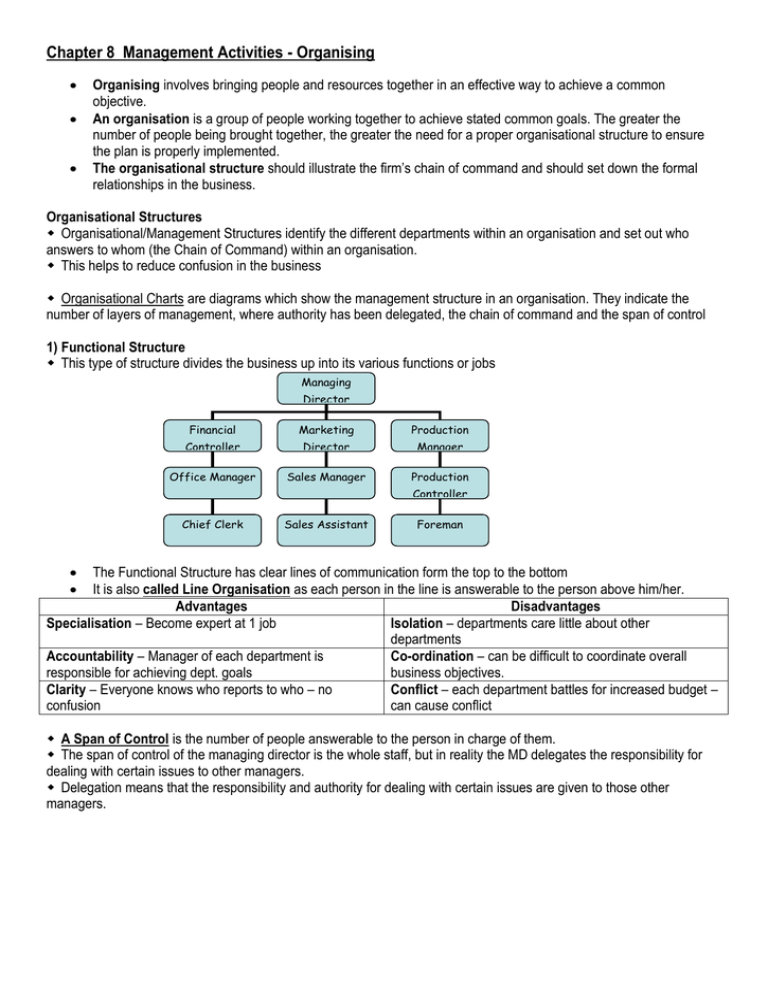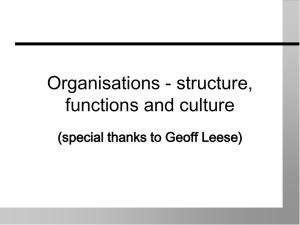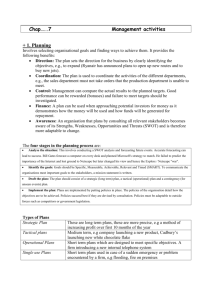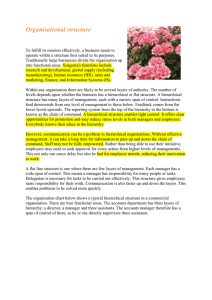File
advertisement

Chapter 8 Management Activities - Organising Organising involves bringing people and resources together in an effective way to achieve a common objective. An organisation is a group of people working together to achieve stated common goals. The greater the number of people being brought together, the greater the need for a proper organisational structure to ensure the plan is properly implemented. The organisational structure should illustrate the firm’s chain of command and should set down the formal relationships in the business. Organisational Structures Organisational/Management Structures identify the different departments within an organisation and set out who answers to whom (the Chain of Command) within an organisation. This helps to reduce confusion in the business Organisational Charts are diagrams which show the management structure in an organisation. They indicate the number of layers of management, where authority has been delegated, the chain of command and the span of control 1) Functional Structure This type of structure divides the business up into its various functions or jobs Managing Director Financial Marketing Production Controller Director Manager Office Manager Sales Manager Production Controller Chief Clerk Sales Assistant Foreman The Functional Structure has clear lines of communication form the top to the bottom It is also called Line Organisation as each person in the line is answerable to the person above him/her. Advantages Disadvantages Specialisation – Become expert at 1 job Isolation – departments care little about other departments Accountability – Manager of each department is Co-ordination – can be difficult to coordinate overall responsible for achieving dept. goals business objectives. Clarity – Everyone knows who reports to who – no Conflict – each department battles for increased budget – confusion can cause conflict A Span of Control is the number of people answerable to the person in charge of them. The span of control of the managing director is the whole staff, but in reality the MD delegates the responsibility for dealing with certain issues to other managers. Delegation means that the responsibility and authority for dealing with certain issues are given to those other managers. A Wide Span of Control In a wide span of control, on person is in charge of quite a number of people Marketing Manager Market Researchers Computer Analyst Sales Manager Sales Operatives Production Manager Advertising Manager A wide span can make life difficult for the person in charge as his/her workload and the number of decisions to be made increases A Narrow Span of Control In a narrow span of control, each person is in charge of only a few people and can give better attention to each one and make decisions much faster. It allows each worker better access to their boss and leads to greater motivation and job satisfaction Financial Controller Office Manager Accounts Clerk The Span of Control is affected by: i. The difficulty of the work ii. The productivity of the workers iii. The frequency with which managers supervise work iv. The ability of managers to supervise people and work 2. Product Structure The Business is split into departments based on products made and sold – the manager may then decide to apply a functional structure for each product. Eg – Department Store Advantages Customer Focused – target market is well known and can create customer loyalty Increased profits – each department tries to outsell the other. Disadvantages Duplication – People do the same job for different products – this may increase costs Brand cannibalisation – one product may steal customers from another product. May seem like sales are increasing – but overall they do not. Lower Costs – Each manager tries to lower their costs as they see it as a separate business 3. Matrix Structure This combines the main elements of a functional organisation structure as it has a vertical chain of command There is also a horizontal structure which combines the various departments into teams to achieve given objectives such as the launch of a new product or development of a new market. The matrix structure organises the business into project teams led by one of the managers who will be designated project leader to achieve the goals. Managing Director Production Manager Marketing Director Sales Manager Human Resource Manager Office Manager Project 1 Production Staff Marketing Staff Sales Staff H.R. Staff Staff Office Staff Project 2 Production Staff Marketing Staff Sales Staff H.R. Staff Staff Office Staff Project 3 Production Staff Marketing Staff Sales Staff H.R. Staff Staff Office Staff Project 4 Production Staff Marketing Staff Sales Staff Advantages Motivation – Employees chosen to lead or be part of a team feel wanted and are motivated to work harder Cooperation – People from different departments cooperate and this improves employee morale. H.R. Staff Staff Office Staff Disadvantages Confusion – employees working in a team and doing their normal job may not know who to report to or what to prioritise. Increases Costs – organising teams increases costs as managers/employees need to be trained and upskilled 4. Geographic Segmentation The Business splits up the business based on the Geographical areas it operates in. Advantages Serves local Needs better – each manager knows their area well – culture/language etc Competition – competition between regions to be the best drives up sales etc Shared Ideas – if something works well in 1 region it can be rolled out in others Disadvantages Duplication – some employees may be doing the same job – this could be centralised – eg payroll and stock control Conflict – many managers may feel they know what is best for the company Knock on effect – a mistake in the European division may harm the image of the American division What Factors Influence the Design of an Organisational Structure 1. Simplicity Organisational Structures should be simple to reduce confusion. 2. Communications Structures should allow for easy communications up and down the organisation 3. Enterprise For firms that need to encourage intrapreneurship, wider spans of control would be appropriate. When control is important firms should use narrow spans of control 4. Costs The less profitable a firm, the less likely it is to be able to afford narrow spans of control and several layers of management 5. Control The more layers of management in a business, the slower the decision-making will be. This makes it easier for managers to control decisions






